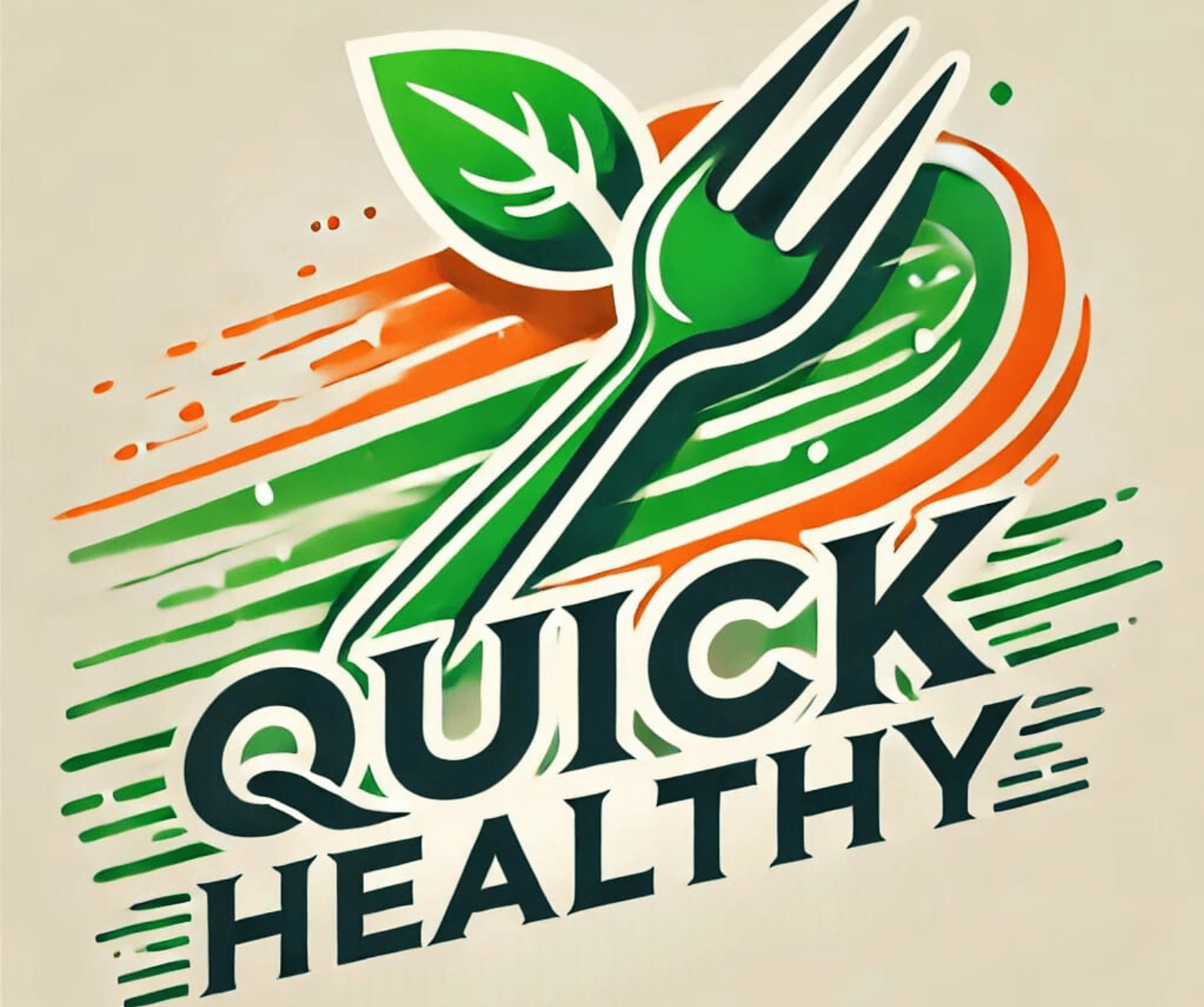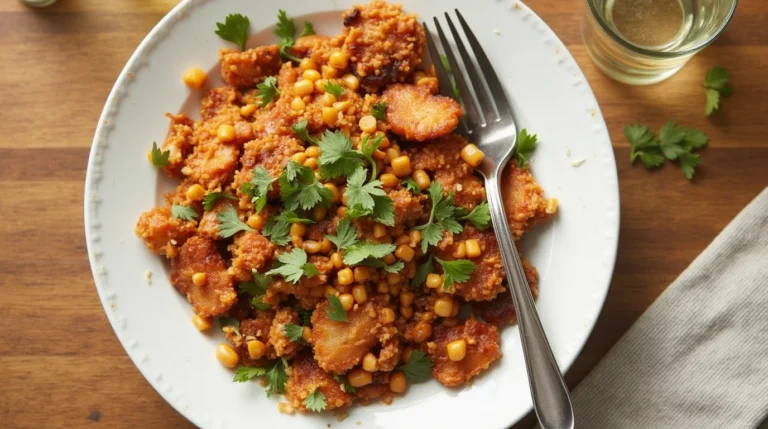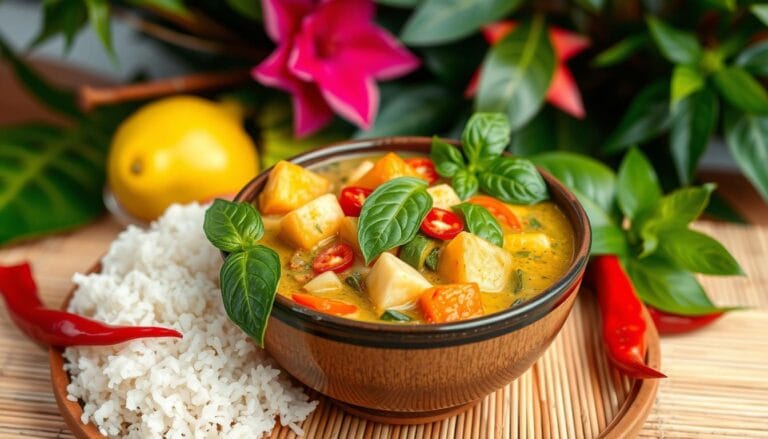Moroccan Vegetable Tagine: A Vegan Delight
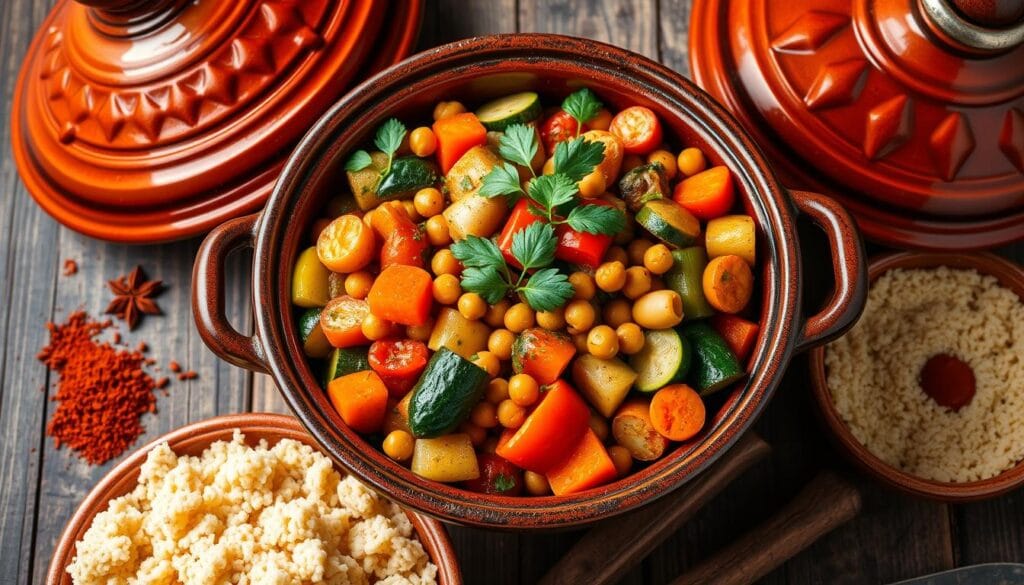
Table of Contents
Moroccan Vegetable Tagine: A Vegan Delight
The first time I tasted a Moroccan vegetable tagine, it was magical. The colors, spices, and flavors were amazing. It showed me that healthy food can be exciting.
Imagine making North African dishes at home. It’s a way to enjoy a balanced diet with plant-based foods. This tagine is more than a recipe; it’s a journey of flavors and wellness.
If you’re vegan or just want to try new recipes, this guide is for you. You’ll learn to make a dish that’s both healthy and tasty. From picking the best veggies to using traditional cooking methods, you’ll see how simple ingredients can become a masterpiece.
Ready to dive into a world where food is both nutritious and creative? Every bite of this dish tells a story of culture and mindful eating. Your cooking journey begins now.
Understanding the Rich Heritage of Moroccan Tagine Cooking
Moroccan cuisine is a deep tradition that turns meal planning into an art. The tagine is more than a pot; it shows North African culture’s love for whole foods and portion control.
Tagine cooking has a long history, blending innovation with cultural wisdom. Recipes were shared across generations, creating a rich culinary legacy that inspires today’s chefs.
Origins of Traditional Tagine Cookware
The Berber tribes created the cone-shaped clay pot known as the tagine. This design lets steam circulate, making dishes tender and flavorful without extra fat.
- Clay construction ensures even heat distribution
- Unique conical lid captures and recycles moisture
- Promotes natural cooking techniques
Cultural Significance in North African Cuisine
“A tagine is not just a meal, but a celebration of community and tradition.” – Moroccan Culinary Historian
In North African homes, tagine is more than food. It’s about welcoming guests, bonding with family, and honoring ingredients. The cooking method keeps nutrients intact, supporting a whole foods approach.
Evolution of Tagine Recipes Through Generations
Today’s chefs mix old tagine recipes with new nutritional ideas. This shows how portion control and mindful eating can be part of cultural cooking.
| Traditional Element | Modern Adaptation |
|---|---|
| Clay Pot Cooking | Enhanced Heat-Retention Techniques |
| Local Ingredients | Global Ingredient Integration |
| Family Recipes | Culinary Innovation |
Essential Ingredients for an Authentic Vegetable Tagine
Making a real vegetable tagine begins with picking top-notch ingredients. These ingredients should highlight the bright tastes of Moroccan food. The quality of your food is key to turning simple veggies into a dish you’ll remember.
The base of a great tagine is fresh, in-season veggies. You should choose:
- Locally sourced root vegetables
- Seasonal bell peppers
- Ripe tomatoes
- Nutrient-rich zucchini
- Tender eggplant
“Cooking is about passion, and selecting the right ingredients is the first step to creating a masterpiece.” – Moroccan Culinary Wisdom
Understanding your ingredients is the first step to mindful eating. Dietary guidelines suggest using a variety of veggies for better nutrition. When making your tagine, add:
- Chickpeas for plant-based protein
- Kalamata olives for depth
- Fresh herbs like cilantro and parsley
The key to a fantastic vegetable tagine is mixing flavors and textures well. Pick veggies that go well together. This ensures a dish that tastes good and is good for you.
Your choice of ingredients shows your dedication to cooking healthy, tasty meals. By focusing on quality and mindful eating, you’ll make a tagine that feeds both your body and spirit.
Eating Healthy Every Corner of the World: Moroccan Style
Exploring global culinary traditions shows us different ways to live healthy. Moroccan cuisine is a great example of healthy foods that feed both body and soul. The Mediterranean diet, seen in tagine cooking, shows us how to eat well everywhere.
Nutritional Benefits of Mediterranean Ingredients
Mediterranean ingredients are full of nutrients that help us stay healthy. Moroccan dishes are packed with good stuff for your body:
- Olive oil is good for your heart
- Fresh veggies give you vitamins and minerals
- Whole grains give you energy
- Legumes are a great source of plant-based protein
Whole Food Components in Tagine Cooking
Tagine cooking focuses on using whole foods. This way, you get more nutrients and flavor. The slow-cooking method keeps nutrients in and makes meals very tasty.
| Ingredient | Nutritional Benefit | Health Impact |
|---|---|---|
| Chickpeas | High protein, fiber | Supports digestive health |
| Turmeric | Anti-inflammatory properties | Reduces chronic disease risk |
| Carrots | Beta-carotene, vitamin A | Promotes eye and skin health |
Balanced Meal Planning with Tagine Dishes
Making balanced meals is easy with Moroccan cooking. Every corner of the world has its own cooking wisdom. Tagine dishes show how to mix proteins, carbs, and veggies for a healthy meal.
“Food is not just eating. It’s an experience.” – Guy Fieri
Step-by-Step Guide to Preparing Your Tagine
Making a tasty vegetable tagine is an art. It mixes healthy eating with old cooking ways. Your path to a balanced diet begins with picking the right ingredients and preparing them well.
Start by picking your fresh veggies and key spices. A healthy tagine needs top-notch, in-season produce. This ensures great taste and health perks.
- Pick veggies that are colorful and full of nutrients
- Get your traditional clay tagine pot or a good substitute
- Chop veggies into the same size for even cooking
- Arrange ingredients in a way that boosts flavors
“Cooking is about passion, and the best meals are made with love and understanding of ingredients.” – Moroccan Culinary Wisdom
Your cooking method is key to keeping veggies nutritious. Low and slow cooking saves vitamins and minerals. This way, you’re not just cooking a meal, but making a whole nutrition experience.
- Use little oil to keep the dish healthy
- Add spices like turmeric and cumin for extra health benefits
- Include protein-rich legumes for a full balanced diet
The secret to a perfect tagine is patience and detail. Let your veggies simmer slowly. This lets them soak up the spices and develop deep, complex flavors. These are what make Moroccan food so special.
Spice Combinations That Make Your Tagine Exceptional
Discover the secret to amazing Moroccan dishes through spices. Start your journey into tagine cooking by learning about the flavors that make simple ingredients special.
Spices are the heart of Moroccan cooking. They turn meal planning into an art that pleases the senses and feeds the body.
Traditional Moroccan Spice Blends
The secret to a great tagine is in its spice mix. Check out these classic Moroccan blends:
- Ras el Hanout: A mix of up to 30 spices
- Harissa: A spicy paste that adds depth and heat
- Chermoula: A herb mix perfect for marinades
Measuring and Mixing Techniques
When using strong spices, portion control is crucial. Follow these tips to get the right flavor:
- Begin with small amounts
- Adjust to taste
- Choose fresh, whole spices when you can
| Spice | Flavor Profile | Recommended Quantity |
|---|---|---|
| Cumin | Earthy, warm | 1-2 teaspoons per dish |
| Paprika | Sweet, mild heat | 1 teaspoon per dish |
| Cinnamon | Sweet, aromatic | 1/2 teaspoon per dish |
Storage Tips for Fresh Spices
“The quality of your spices determines the soul of your dish.” – Moroccan Culinary Proverb
Keep your spices fresh with these tips:
- Store in airtight containers
- Keep away from direct sunlight
- Use within 3-6 months for best flavor
Mastering these spice techniques will make your tagine a special experience. It celebrates whole foods and mindful cooking.
Mindful Cooking Techniques for Perfect Results
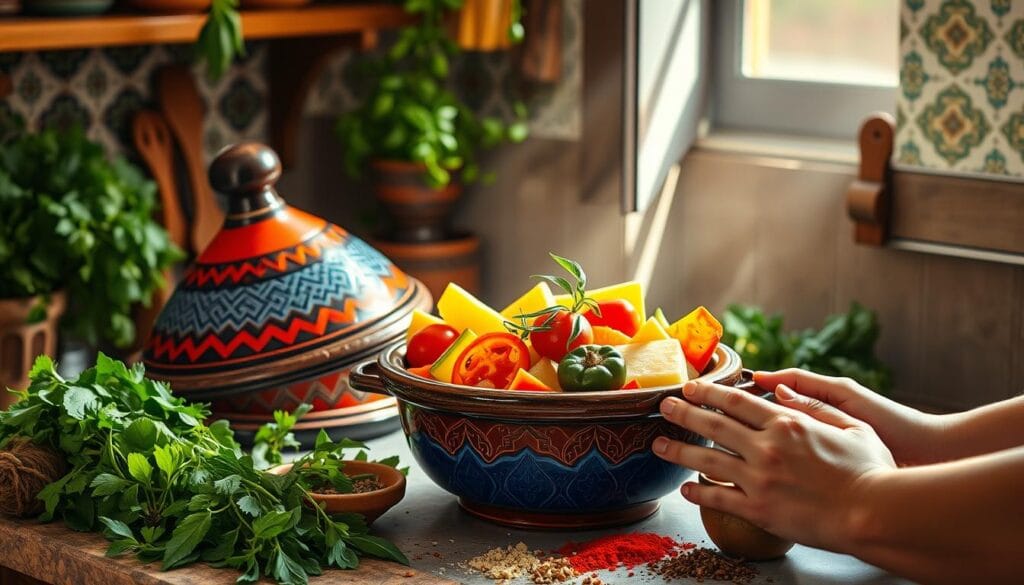
Making a perfect tagine is more than just following a recipe. It starts with the quality of your ingredients and how you cook. This turns meal prep into a thoughtful journey. Every ingredient and technique plays a key role in mindful eating.
Here are some key mindful cooking techniques for your tagine:
- Practice intentional ingredient selection – choose fresh, locally sourced vegetables
- Engage all senses during preparation
- Slow down your cooking process
- Understand each ingredient’s nutritional profile
“Cooking is an art that nourishes both body and soul” – Moroccan Culinary Proverb
Following dietary guidelines means choosing cooking methods that keep nutrients intact. Tagine cooking fits perfectly with this, using slow, gentle heat. This method keeps vitamins, minerals, and flavors in, making meals deeply satisfying.
Your mindful cooking turns a routine into a meditative practice. By focusing on quality and intentional prep, you make more than a meal. You create a holistic experience that nourishes both body and mind.
Seasonal Vegetable Selection for Maximum Flavor
Creating a delicious Moroccan vegetable tagine is all about picking the right veggies. Choose from around the world for a healthy twist. These nutritious foods add amazing flavor to your dish.
Choosing the best veggies for your tagine changes with the seasons. It’s all about being flexible and creative in the kitchen.
Spring and Summer Vegetables
In warmer months, your tagine shines with fresh, vibrant veggies:
- Zucchini and yellow squash
- Bright bell peppers
- Tender eggplant
- Fresh green beans
- Sweet cherry tomatoes
Fall and Winter Options
Colder seasons bring hearty, rich veggies for warm tagines:
- Butternut squash
- Root veggies like carrots and parsnips
- Cauliflower
- Turnips
- Robust sweet potatoes
Local Substitutions Guide
| Original Vegetable | Potential Substitution |
|---|---|
| Zucchini | Chayote squash |
| Eggplant | Firm tofu or mushrooms |
| Bell Peppers | Poblano or Anaheim peppers |
Your local market is full of unique veggies. Feel free to try new things and make your own special tagine. It can show off your local ingredients while keeping the dish’s traditional feel.
*”Cooking is about passion, creativity, and making the most of what’s available.”* – Unknown Chef
Serving and Presentation Tips for Your Tagine
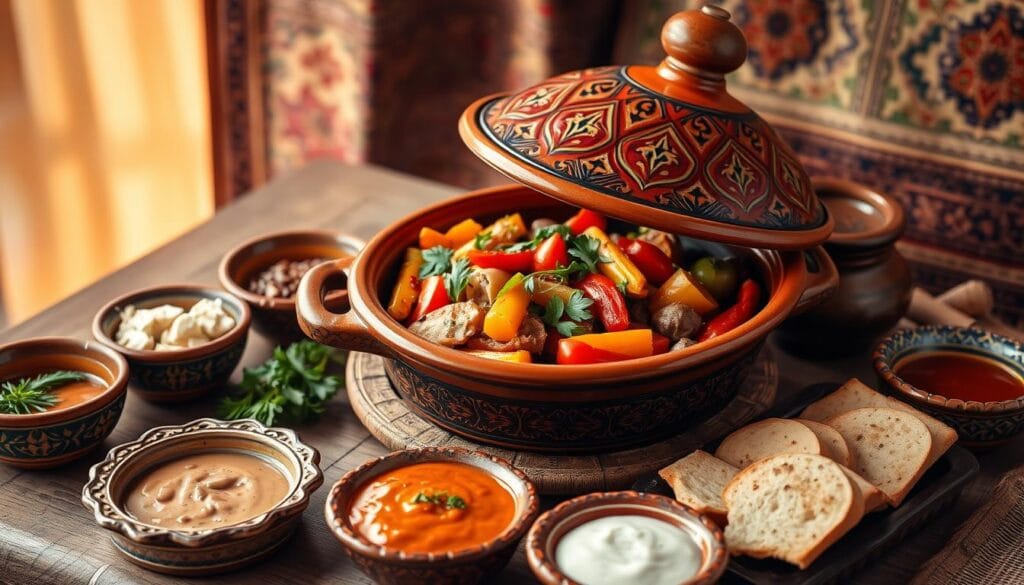
Presenting your vegetable tagine is more than just putting food on a plate. It’s about making your dish look good and be healthy. Moroccan traditions focus on making food look good and be balanced.
“In Moroccan cuisine, how you serve food is just as important as how you prepare it.” – Moroccan Culinary Expert
Your tagine should show off the colorful veggies and make your guests excited to eat. A nicely set plate shows you care about the nutrition and effort you put into your meal.
- Use a traditional clay tagine serving dish for authentic presentation
- Arrange vegetables in a circular pattern to showcase color variety
- Garnish with fresh herbs like cilantro or parsley
- Serve with whole grain couscous for added nutritional value
Here are some tips to make your tagine look great:
| Plating Technique | Nutrition Impact |
|---|---|
| Centered vegetable arrangement | Highlights vegetable diversity |
| Height variation | Creates visual interest |
| Color contrast | Indicates nutrient range |
A beautifully presented tagine does more than just look good. It makes you think about eating more mindfully. Your goal is to make a meal that’s both tasty and healthy.
Pairing Suggestions and Complementary Dishes
Enhancing your Moroccan vegetable tagine is more than just the dish. It’s about choosing the right whole foods and planning your meals well. The right sides can make your meal better and keep portion sizes in check.
Traditional Accompaniments
Classic pairings for your tagine show off true Moroccan cooking:
- Fluffy couscous with fresh herbs
- Warm flatbread for soaking up sauces
- Crisp cucumber and tomato salad
- Roasted almonds as a protein-rich garnish
Modern Fusion Options
Today’s meal planning lets you mix up old recipes. Try these new whole foods pairings:
- Quinoa instead of traditional grains
- Cauliflower rice for low-carb alternatives
- Zucchini noodles with tagine sauce
Beverage Pairings
Your drink choice can really boost the tagine’s flavors:
- Moroccan mint tea
- Light, crisp white wines
- Sparkling water with citrus
“Good food is all about balance and understanding your ingredients.” – Moroccan Culinary Wisdom
Don’t forget, portion control is crucial. Pick sides that enhance your vegetable tagine without overpowering it.
Storage and Leftover Management Tips
Keeping your Moroccan vegetable tagine fresh requires smart storage and reheating. Your mindful eating journey doesn’t end with the meal. It continues with clever leftover management, ensuring your dish stays tasty and healthy.
- Cool the tagine to room temperature within 2 hours of cooking
- Store in airtight glass containers
- Refrigerate for up to 3-4 days
- Use shallow containers to ensure even cooling
“Proper storage is the secret to maintaining the vibrant flavors and nutritional value of your home-cooked meals.”
Reheating needs careful attention to keep food quality high. Use gentle, low-temperature methods to avoid ingredient damage and keep the spice blend intact.
| Storage Method | Duration | Best Practices |
|---|---|---|
| Refrigerator Storage | 3-4 days | Airtight glass container |
| Freezer Storage | 2-3 months | Freeze in portion-sized containers |
| Reheating | Low heat | Add small splash of water |
Mindful eating goes beyond the first meal. By storing and reheating your tagine wisely, you cut down on waste and get the most nutritional value from your cooking.
Conclusion
Starting your Moroccan vegetable tagine cooking journey is more than just learning a new recipe. It opens the door to a healthy lifestyle through global cuisines. You’ve seen how nutritious foods can change your cooking.
Tagine cooking shows that eating well has no limits. It brings together flavors from around the world. This dish is a mix of nutrition, culture, and taste.
You’ve grown your cooking skills, making dishes that are tasty and healthy. You’ve learned about choosing ingredients, mixing spices, and preparing food. These skills help you make better food choices, celebrating global food traditions.
Keep exploring international recipes. Cooking is a journey of learning and discovery. Your tagine knowledge helps you see how cultures view nutrition, flavor, and cooking.
FAQ
What makes a Moroccan vegetable tagine a healthy meal option?
A Moroccan vegetable tagine is packed with nutrients. It’s made with whole foods, lots of veggies, and balanced spices. This dish is full of vitamins, minerals, and plant-based proteins. It’s also low in calories and high in fiber.
The slow-cooking method keeps nutrients in and makes the dish flavorful. It supports your healthy eating goals.
Can I modify the tagine recipe if I have dietary restrictions?
Yes, you can! The vegetable tagine is very flexible. You can make it gluten-free, vegan, or change the veggies based on what’s in season. The cooking method stays the same, so you can keep the dish healthy and tasty.
How long does it take to prepare a traditional vegetable tagine?
It takes about 60-90 minutes to make a vegetable tagine. You’ll chop veggies, mix spices, and cook it slowly. The effort is worth it for a meal that’s good for you and can feed many people.
What type of cookware do I need to make an authentic tagine?
You don’t need a clay tagine pot to make a real tagine. A heavy-bottomed pot with a tight lid, like a Dutch oven, works great. It’s all about even heating and rich flavors.
Are tagines suitable for meal prep and storage?
Yes, they’re perfect for meal prep and storage. They stay fresh in the fridge for 3-4 days. Reheating them makes the flavors even better, making it a great choice for mindful eating.
How can I ensure I’m getting proper portion control with a tagine?
Tagines help with portion control naturally. They’re full of veggies, legumes, and a bit of protein. Use a standard bowl and pair it with a small amount of whole grains. Fill half your plate with the tagine for a balanced meal.
What are the key spices used in a traditional Moroccan vegetable tagine?
Traditional Moroccan tagines use spices like cumin, coriander, turmeric, cinnamon, paprika, and sometimes saffron. These spices add amazing flavor and health benefits, like fighting inflammation and boosting metabolism.
Can children and picky eaters enjoy a vegetable tagine?
Yes, with some planning, tagines can be a hit with kids and picky eaters. The veggies are tender from slow-cooking, and you can adjust the spices. Letting kids help cook and presenting it nicely can make them more excited to try it.
